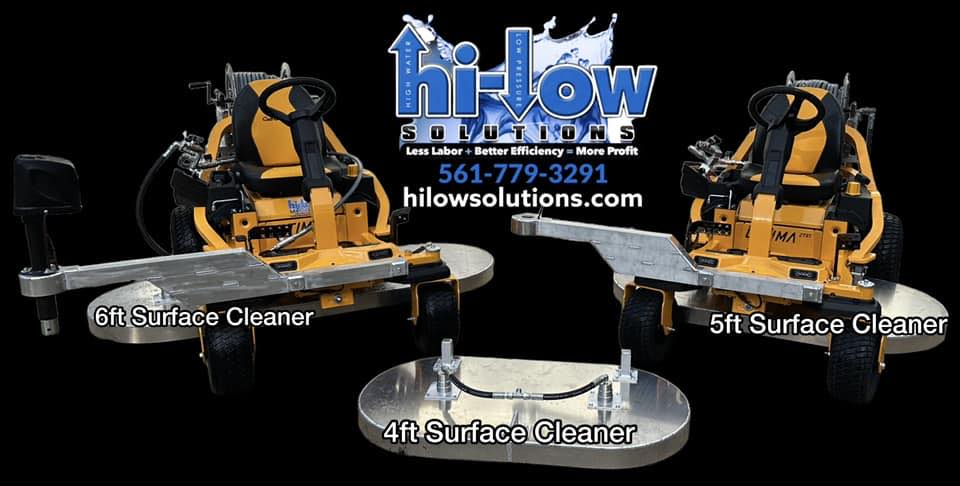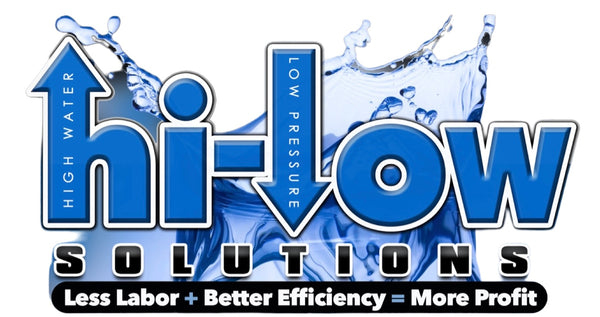
Can You Use Surface Cleaner with PSI Pressure Washer? – Expert Guide for Optimal Cleaning
Share
Pressure washers are known to help with effortless cleaning, combining efficiency with powerful cleaning capabilities. A common question is, "Can you use a surface cleaner with a PSI pressure washer?" This query highlights the need for clear guidance on the compatibility and optimal use of pressure washing equipment. The global market for pressure washers is on a significant upward trajectory, with projections indicating a rise to $3.1 billion by 2028, as reported by Statista. This surge underscores the increasing reliance on and relevance of pressure washers for residential and commercial applications. In this expert guide, we go in-depth about using surface cleaners with PSI pressure washers, ensuring you achieve thorough cleanliness and maintain the longevity and effectiveness of your cleaning equipment.
Understanding Pressure Washers and Surface Cleaners
To thoroughly understand the mechanics of pressure washers and surface cleaners, it's essential to understand the key metrics that govern their performance. GPM (gallons per minute) and PSI (pounds per square inch) are fundamental aspects that determine how effectively and efficiently these tools operate. Next, we will learn about these factors in detail to better grasp their critical roles in the pressure-washing process.
You can explore high-performance washers like the Hi-Low 2850 PSI 17 GPM Pressure Washer or the Hi-Low 3500 PSI 10 GPM Pressure Washer for tough jobs.
What is PSI and Why Does It Matter?
PSI is a unit of measurement that accurately sets the value of the pressure output by pressure washers. This metric directly impacts the efficacy of the cleaning process. A higher PSI means more power to dislodge grime and dirt from surfaces, making pressure washers with a high PSI rating beneficial for tackling tough stains and heavy build-up. When using a surface cleaner attachment, the PSI level of your pressure washer determines how deeply and effectively the cleaner can penetrate surface dirt. Choosing a PSI level appropriate for the cleaned surface is essential to avoid damage.
The Role of GPM in Pressure Washing
GPM is the unit for the flow rate of water that a pressure washer dispenses. This factor is equally essential as PSI because it affects how quickly you can clean a surface. A higher GPM allows for faster rinsing and cleaning over larger areas, making it necessary when using surface cleaners for expansive surfaces. The combination of GPM with the appropriate PSI uplifts the cleaning power of pressure washers, ensuring efficient and effective removal of dirt and residues. One can rightly say that while PSI tackles the toughness of the dirt, GPM determines the speed and extent of the cleaning, underscoring their roles in efficient pressure washing.
Matching Your Surface Cleaner with Your Pressure Washer
As the demand for efficient home cleaning solutions grows, understanding the compatibility between your surface cleaner and pressure washer becomes crucial. Recent data from Grand View Research shows that the residential segment generated over 60% of pressure washer revenue in 2020, highlighting the predominance of homeowners in search of dependable cleaning tools. Ensuring your equipment matches perfectly will optimize your cleaning efforts and extend your tools' lifespan.
We recommend tools like the Curbinator on Wheels, ideal for maneuvering during large-scale surface cleaning.
Equipment Compatibility and Nozzle Selection
Your pressure washer's proper nozzle and orifice size play a crucial role in enabling effective outdoor cleaning.
- Nozzles control the spray pattern and intensity, which is adjustable to suit different cleaning tasks. The orifice size affects the pressure output and must be compatible with your pressure washer's PSI and GPM specifications to ensure optimal performance.
- Start by identifying the surface type and the kind of debris you need to remove.
- A 15-degree nozzle is sufficient for general cleaning, balancing coverage, and pressure.
- For more intense cleaning, such as removing stains from concrete, a 0-degree nozzle provides a powerful, pinpoint spray.
- Always refer to the manufacturer's guidelines to match the nozzle size with your pressure washer's capacity.
This step-by-step approach ensures you use the right tools for each cleaning task, improving efficiency and protecting your surfaces from damage.
Setting the Correct Pressure and Flow Rates
Adjusting the PSI and GPM settings on your pressure washer is essential to avoid common issues like uneven cleaning or potential surface damage.
- Lower PSI settings are advisable for delicate surfaces such as wood decking to prevent etching or stripping of the material.
- Conversely, hard surfaces like driveways and concrete paths may require higher PSI levels to remove dirt and stains effectively.
- Similarly, the GPM should be adjusted based on the area size and the type of dirt being cleaned. A higher GPM can cover larger areas more quickly but uses more water.
- Balancing these settings according to the cleaning requirements provides a thorough cleaning without wasting water or damaging your property.
- Always start with lower settings and increase as needed, checking the results step-by-step to ensure you achieve the desired cleanliness without overburdening your surfaces.
- This careful calibration of pressure and flow is key to mastering outdoor cleaning with a pressure washer.
Practical Setup: Step-by-Step Instructions
Setting up your pressure washer with a surface cleaner attachment correctly is crucial for achieving optimal cleaning results without causing damage. This section will guide you through the installation process and share essential maintenance tips and safe operation practices to ensure your equipment remains in top condition.
Installing the Surface Cleaner Attachment
- Check Compatibility: Ensure your surface cleaner attachment matches your pressure washer model. This includes checking the PSI and GPM ratings.
- Attach the Cleaner: Turn off the pressure washer and disconnect it from the water supply. Attach the surface cleaner to the wand or lance of your pressure washer, ensuring it is securely fastened.
- Connect to Water Supply: Connect your pressure washer to the water supply and turn it on to check for leaks.
- Test Before Use: Perform a quick test on a small, inconspicuous area to ensure the attachment works correctly and the settings are appropriate for your cleaning surface.
Best Practices for Operation and Maintenance
- Regular Inspection: Before each use, inspect the surface cleaner for any signs of wear or damage. Check hoses, nozzles, and connections for leaks.
- Cleaning Nozzles: After every use, clean the nozzles to prevent blockages. This can be done by running clean water through the surface cleaner while still attached to the pressure washer.
- Storage: After cleaning, fully dry the surface cleaner attachment before storing it in a dry, cool place to avoid corrosion and extend its lifespan.
- Safety First: Always wear protective eyewear and clothing when operating the pressure washer. Avoid using the surface cleaner on surfaces easily damaged by high pressure.
Expert Tips and Personal Experiences
Gathering insights from professionals and experts can significantly improve your pressure-washing skills. Here are some critical tips and troubleshooting advice from real-world experiences:
- Pre-Cleaning Assessment: Always assess the surface type and level of dirt before selecting your pressure settings. This approach minimizes damage and increases cleaning efficiency.
- Even Movement: When moving the surface cleaner, maintain a steady, even pace. Quick movements can lead to uneven cleaning, while too slow a pace might damage the surface.
- Tackling Stubborn Stains: For tough stains, pre-treat the area with a detergent or a suitable cleaning solution before using the surface cleaner. This softens the dirt, making it easier to remove.
- Troubleshooting Leaks: If you notice a decrease in pressure or a leak, check all connections. Tightening or replacing a worn-out hose or connection can soften or solve the problem.
- User Feedback: Many users recommend regularly checking and replacing the water inlet filter, as clogs here can reduce cleaning effectiveness and damage the pump over time.
Frequently Asked Questions
1. Can you put a surface cleaner on any pressure washer?
Yes, a surface cleaner can be attached to various pressure washers. Still, for optimal performance, it's essential to match the cleaner's requirements with the pressure washer's pounds per square inch (PSI) and gallons per minute (GPM) output.
2. What PSI is needed for a surface cleaner?
Surface cleaners typically require at least 3000 PSI to operate effectively, although many models are designed to handle up to 4000-5000 PSI for more demanding cleaning tasks.
3. What cleaner can I use in a pressure washer?
You should use detergents made specifically for pressure washers or a mild dish soap. Avoid harsh chemicals to protect your equipment and the surfaces you're cleaning.
4. When should you use a pressure washer surface cleaner?
A pressure washer surface cleaner is best used for large, flat outdoor areas such as decks, patios, driveways, and parking lots. It provides even and thorough cleaning.
5. Is 4000 PSI too much for concrete?
While 4000 PSI can be suitable for commercial concrete, a PSI range of 2500-3000 is typically recommended for residential concrete to prevent damage to the surface.
6. Can you use Super Clean in a pressure washer?
Yes, Super Clean can be used in a pressure washer if adequately diluted according to the manufacturer's instructions. This ensures both effective cleaning and protection of the equipment.

